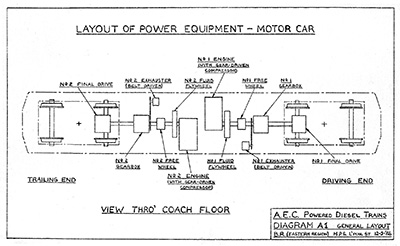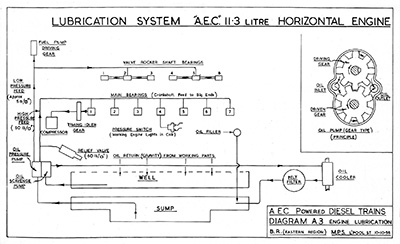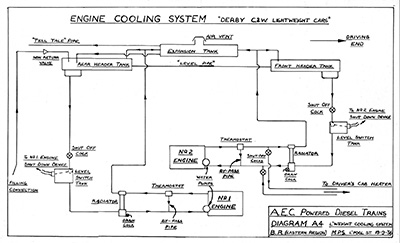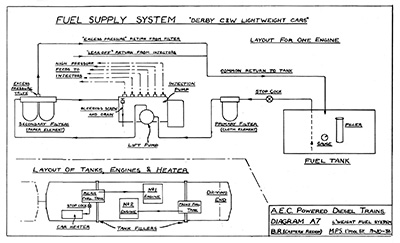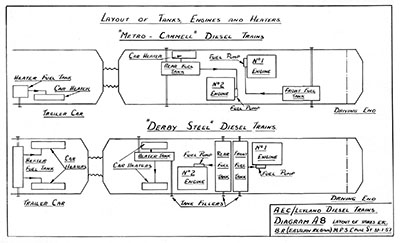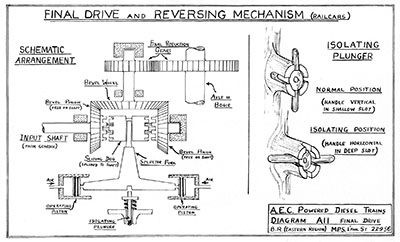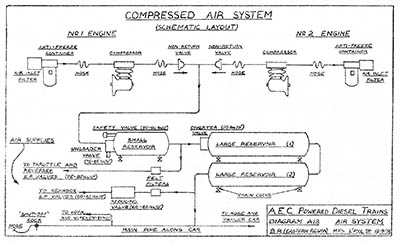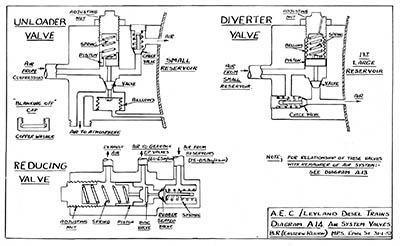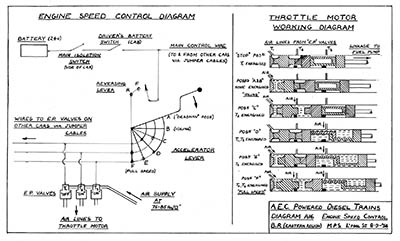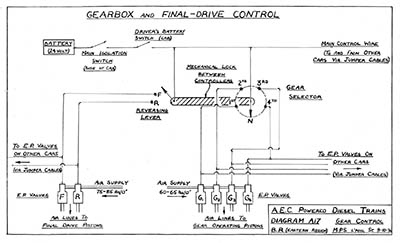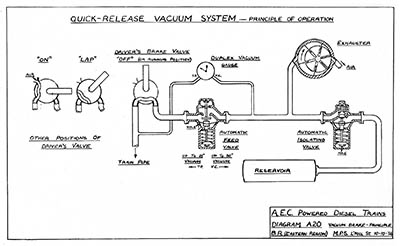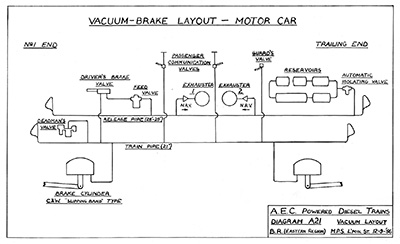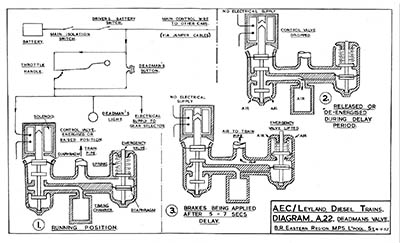Staff Training
Eastern Region
The Region began to receive DMUs in 1955 with Yellow Diamond Derby Lighweights (for Lincoln and East Anglia) and Met-Camm Lightweights. The following year it began to receive Blue Square units.
It initially opened a diesel school at Hadley Wood which was soon moved to Ilford. It would make use of a mobile diesel instruction train which would visit motive power depots.
Hadley Wood Training School for Diesel Drivers (opened Autumn 1956)
The Eastern Region opened a school for training steam locomotive drivers in diesel techniques at St Ronans, Hadley Wood. Drivers from all parts of the Region would attend the school for a two week course with specialist instructors.

A driver trainee at the controls of a Met-Camm Lightweight unit circa October 1956 while on the second week of the Hadley Wood course. The small white board in front of him has the speed ranges for each gear. British Railways.
The first week of the course was spent largely in the lecture room, and the second week operating DMU out on the line. The training sylabus began with an introductory talk on the theory of diesel power and was followed by lectures and demonstrations of the diesel engine, its fuel injection, transmission and final drive, and the control and vacuum systems. These lectures were spread over the first week, each day being split into periods, two in the morning and two in the afternoon.
At the end of the Friday on the first week the drivers were introduced to the diesel train where they were able to see the layout and function of the equipment covered during the lectures, and as a preparation for the actual control and handling during the second week.
Each course would consist of twelve drivers, and was soon training drivers from depots such as Lincoln, Boston, Grantham, Stratford, Kings Lynn and Norwich. At the time only 55 sets were in operation on the Eastern Region, the school was opened to prepare and train drivers in readiness for the extension of diesel-operated services.
Information extracted from an British Railways press release reproduced in Railway Gazette (p592 16 November 1956) and The Locomotive (p216 November 1956).
The line used for the hands-on training was, or included, the New Barnet - Harston route. Derby Heavyweight set E50007 + E56007 were noted on this duty circa early 1957.[1]
Due to a derailment at Welwyn Garden City on 7 January 1957 the two-car set allocated to the training school was commandeered to run a shuttle service between Hatfield and Welwyn Garden City[2].
Training School Diagrams
This series of loose sheets were marked "BR (Eastern Region) M.P.S. L'Pool St" and are mostly dated September 1956.
Ilford Training School for Diesel Drivers (opened January 1957)
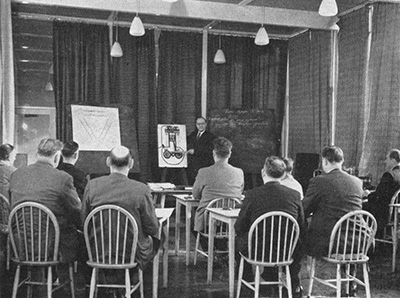
In January 1957 the diesel school was transferred from Hadley Wood to Ilford. It was initially temporarily located within the staff hostel at Ilford, with recreation room being used in the daytime as a classroom (seen in the first image), another used for models and charts. Accomodation was arranged nearby for trainees, permanent self-contained accomodation was planed to be built nearby.
Every week twelve new trainees started, meaning there were twenty-four in the school under training at one time. Courses on diesel locomotives were introduced by the end of the 1957 as the Region had now received its first mainline diesels (Brush 1250hp).
Railcar courses still involved one week in the classroom and one week on the traction. The course covered topics meant for maintenance staff as drivers were expected to be able to diagnose faults and failures while in service and be able to rectify them if possible.
The classroom lectures were designed following guidance from the British Railways Instructors School at Darlington. Training school staff included three instructors and a chief instructor. At the start of the course trainees were provided with notebooks to take their own notes, and diagrams (show above) would be handed out during the lectures. At the end of each week there was an oral exam.

Three Stratford allocated units were normally used on the course during the week, one of each of the three types it had (Derby Lightweight, Met-Camm Lightweight and Wickham) to give drivers a wider experience.
In the image an instructor explains the jumper sockets on a Met-Camm Lightweight unit to drivers on the second week of their course circa November 1957.

In the final image a trainee driver is at the controls of a Met-Camm Lightweight while others await their turn to drive. Circa November 1957.
The training runs ran over specified sections, timetabled to phase in with normal traffic, and each of the twelve attendees would complete some 100 miles of driving under instruction which included between 20 and 30 station stops.
Maintenance staff by this date had been trained by sending a limited number of fitters for training by the equipment manufacturers, they would then share this knowledge with their collegues. To improve on this plans were in place to set up a dedicated school for them, probably at Stratford.
Information extracted from an article "Diesel Training in the Eastern Region" that appeared in Railway Gazette (p627 29 November 1957).
Mobile Instruction Train

The Eastern Region was the first Region to receive a diesel instruction train in mid-1957. The train comprised of two converted coaches. One held the display room showing some of the components of diesel railcars and locomotives. Many of the components were in pieces or sectioned, and there was a complete set of controls including the various indicator control lights arranged to simulate a vehicle in service.
The same vehicle had a Lister generator at one end to provide power. The other vehicle held a lecture room (seating 38), a projection room (equipped with two cinema projectors with full sound equipment, a slide and filmstrip projector, and an epidiascope), and living quarters for the Resident Instructor. At least one vehicle had DMU style Smiths heaters. The conversion work was done at Derby.
The train would tour all the major motive power depots on the Region, staying up to a week or longer depending on the number of depot staff. The instructional facilities available on the train were in addition to the normal training given to drivers and technical staff, the visit of the train to each centre would provide the staff with an opportunity for refresher training.[3]
Its use was noted as being on a "voluntary basis, in conjunction with local mutual improvement classes, to stimulate interest of all personnel, drivers and shed staff, in diesel units. In the case of drivers who have been trained, it will act as a refresher, while with untrained personel, or at depots where diesels have not yet been received, it is hoped that the train will provide an insight into some of the technicalities of the diesel locomotive and railcar." Also "no scheme of regular refresher training is at persent envisaged for drivers who have passed through the diesel school at Ilford, as it is felt that a satisfactory standard is being reached: inspectors, trained as diesel drivers, do, however, accompany diesel drivers from time to time on service runs, to ensure that the standard is being maintained."[4]

The second image show running shed staff receiving instruction in the model room circa November 1957. The circular object is a fluid flywheel, normally attached to the output end of an engine, and in the foreground is a cardan shaft, possibly with a sectioned freewheel.
The two vehicles (DM395225/6) were on public display at the "Modern Railway Travel Exhibition" in Battersea Wharf Goods Yard, 28-30th June 1957.
The two vehicles (4A and 4B) were noted as having been at Aldersbrook Sidings, Ilford, for some months at the end of 1957. [5]
How long it remained in use is unknown, but the vehicles made it into the blue era, being noted at York painted into plain blue.
References
- ⋏ p55 February 1957 Railway Observer
- ⋏ p165 March 1957 Trains Illustrated
- ⋏ "Eastern Region Diesel Instruction Train", p142 2nd August 1957 Railway Gazette
- ⋏ "Instruction Train", p628 29th November 1957 Railway Gazette
- ⋏ p347 January 1958 Railway Observer
The Railway Observer is the journal of the Railway Correspondence and Travel Society
Introduction
Eastern Region
London Midland Region
Scottish Region
Mobile Instruction Train



